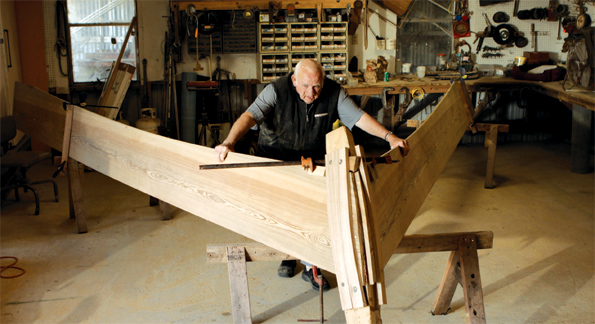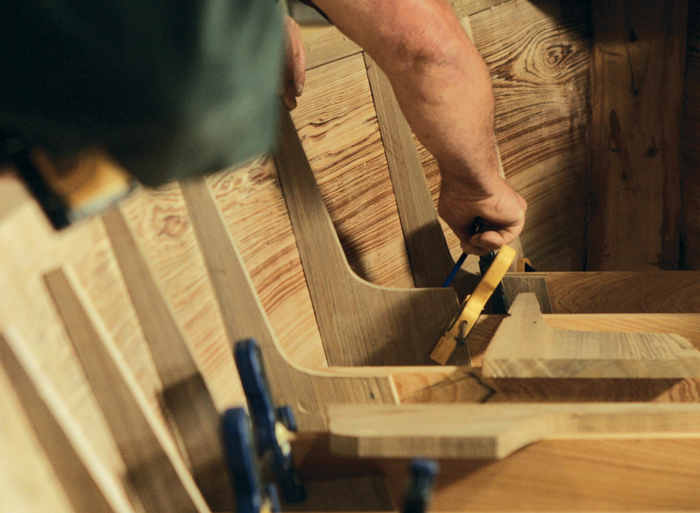Magazine
In the Mind of the Maker
Traditional Louisiana boat building practices offer insights for cognitive science
Published: September 1, 2016
Last Updated: May 2, 2019
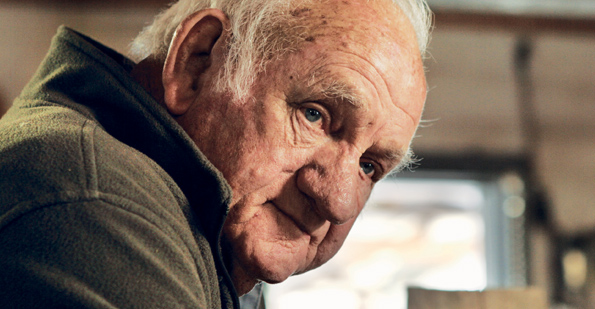
Brian C. Miller Richard
Born a year after the Great Flood of 1927, Couvillier has spent his whole life aboard boats of one kind or another. He grew up in the Atchafalaya Basin amid a community of houseboats clustered in a remote part of the swamp near Hog Island. To build a good life in a place like this demands a particular kind of creativity. From putting food on the table to making a home for himself and his family on the edge of wild places, his way of life has been an ongoing exercise in problem-solving and invention, demanding a variety of intelligence seldom required of those living in less remote environs. What he needs, he must form with his hands. But for Couvillier, it’s not enough that the things he makes are useful—they must be beautiful, too. Especially the boats.
The Basin has changed a great deal since his childhood, and much of it has since silted up into dry land. “But back then, you had water all over. You had to have a boat. What I call a good boat is a pretty boat. You know, something that’s nice to look at. Like a good-looking woman.”
The old man catches himself and laughs a little at what he’s just said. You can make a box float and get the job done, he explains. But if you’re going to go to the trouble of building a boat, why not make something lovely?
Living in the wetlands demanded different boats suited to different purposes. Some were designed for fishing and hunting; for business, like tending beehives and processing honey, hauling herds of livestock or collecting Spanish moss; some for moving cargo to market, while others were just for ferrying people from place to place. On cold mornings, like kids at a modern bus stop, the Basin’s children waited for warm school boats to come and take them to class. Steam-powered paddle wheelers still moved freight on the Atchafalaya in Mr. Edward’s time; and loud, smoky two-stroke motors called “putt-putts” turned old wooden bateaus into speeding hotrods. (Comparatively speaking, of course.) There was even a church, built atop a long barge, that regularly made the rounds of the Basin and visited the community of houseboats where Couvillier grew up.
“Almost everybody that had a boat could build a boat,” Couvillier remembers. “Most of us were pretty good carpenters.”
On this afternoon, sunlight falls in shafts through the smudged windows of the old man’s workshop and, in the air, sawdust hangs in perpetual clouds. Edward Couvillier’s three sons—Justin, Larry, and Kevin—are handling all the heavy lifting. Their father is here to watch and supervise. In the middle of the room, mounted on sawhorses, are the beginnings of a boat, the “Creole-rowing skiff.” For now, it’s not much more than just a bare yellow skeleton of planks and sticks. Before a boat is built, it is implied in lines that only the builder can see.
The eldest son, Larry, pushes a heavy wood plane along the slope of what will become the starboard gunnel. A pale, paper-thin shaving of cypress curls back away from the blade, leaving behind it a line as straight and pure as a Euclidean dream. He steps aside so that his father can lean in and look at his handiwork. The old man stoops, eyeing the edge that Larry has smoothed and nods approval.
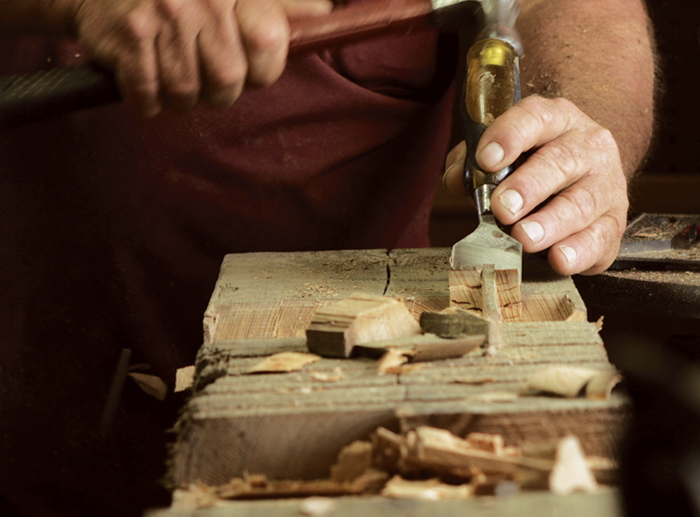
Photo by Brian C. Miller Richard.
Couvillier’s workshop is stacked with great planks of “sinker cypress,” milled from giant, thousand-year-old trees that were logged in the Basin after the Civil War and have rested at the bottom of bayous ever since. Here, arrayed on the walls and surrounding workbenches, there are hammers, hand planes, rasps, sanders and power saws: tools of every kind.
Conspicuously missing, however, are the design specs for the push skiff. There are no blueprints for building boats like these, no plans or patterns. Not even a sketch. Boats of this kind, like most of Louisiana’s traditional designs, are not documented anywhere on paper. They exist primarily in the minds of their makers.
For generations throughout coastal Louisiana, families like the Couvilliers had built their entire way of life upon the soft-swaying decks of boats that boasted curious and varying designs. But, by the 1970s, that way of life was quickly disappearing, and with it would go the plans and techniques for constructing some of the most elegant and uncommon watercraft in America.
A few farsighted preservationists began working to maintain this fading memory, like folklorist James Delahoussaye; Tom Butler of the Center for Traditional Louisiana Boat Building in Lockport, LA, on Bayou Lafourche; and Dr. C. Ray Brassieur at the University of Louisiana at Lafayette. They sought out the Atchafalaya Basin’s aging master boat makers, including Alex Giroir and Raymond Sedotal—both long passed now, and revered as nearly legendary builders by later generations for the artifacts of their craftsmanship they left behind. Learning what they could, the researchers spent hours in the workshop with the old men or sitting at their kitchen tables with a cup of coffee and a notebook.
There are no blueprints for building boats like these, no plans or patterns. Not even a sketch. Boats of this kind, like most of Louisiana’s traditional designs, are not documented anywhere on paper.
But it was no use asking them to draw out their designs and measurements on paper. If you did, the old builders would reply, “Mais, how come you want to look at a picture of a boat? Let’s go build one!”
“We didn’t know what a blueprint was,” Couvillier says, laughing. “You just picture in your mind, how it’s going to look. And that’s the way you build it, the way it’s in your mind.”
A Creole-rowing skiff is no plain old pirogue, cobbled together from a few pieces of marine plywood. It’s a relatively complicated boat with a flat, rockered bottom and flared gunnels that sweep back and round outward from a pointed bow. The prow of the Couvilliers’ boat is subtly curved, giving the hull its somewhat voluptuous form. It’s shaped a little like an East Coast dory, but the similarity ends there. The Creole rowing skiff differs from just about every boat on the water because of an innovation called the joug, or “yoke” in English. The joug is a sturdy crossbeam resting on braces that arise from the gunnels. Spanning the skiff at midship, it serves as a sort of fulcrum for the boat’s exceptionally long oars, holding them in place with cords. In almost all rowboats, the pilot sits facing the stern, pulling the oars, and looking over his shoulder to correct his course. This won’t do in the swamps of Louisiana, though. So the joug reverses the entire configuration, allowing the pilot to stand and pull the long oars. Thus, he faces the bow from a higher point above the water so he can keep a sharp lookout and, with a twist of his wrists, deftly maneuver around cypress knees and mud shoals. It’s a cleverly engineered craft, requiring precisely proportioned pieces fitted together, watertight.
So how do you build something so complex with only a memory, a mental image, to work with? I have asked Couvillier this same question many times, many different ways.
“Well, it’s in your head,” he says, as though nothing could be more obvious. “How you want to build it. You think about how big a boat you want, what size you want, and what you want it to look like, and you go from there.”
I stare blankly. He tries again, but I can only muster the same response.
His son, Larry Couvillier, gives it a try.
“When you’re building a boat, it never leaves your mind,” Larry offers. “You’re always looking at it, you’re always thinking about it, you’re always picturing it in your head and what you want to accomplish. In the end, it just all comes together.”
But, again, how?
After a few conversations, it occurred to me that I was asking the old boat builder some of the oldest and toughest questions in philosophy. What are mental images? How do we imagine and recall them in ways that relate to the real world?
From Plato and Aristotle to Augustine, from Leibniz to Locke, down through Hobbes, Hume, and Husserl, human beings have struggled to grasp how we “see with the mind’s eye.” To understand the phenomenon of mental imagery is to begin to comprehend memory, imagination and thinking itself. Naturally, anything of this sort of consequence is bound to stir controversy.
And no small amount of dissension. Debate over the topic of mental imagery has smoldered for centuries, the trouble being the difficulty the mind has in looking inward to understand itself. Wrestling with such subjects, William James famously concluded, “The attempt at introspective analysis in these cases is, in fact, like…trying to turn up the gas quickly enough to see how darkness looks.”
Even so, there’s something important to be learned from those who are especially accomplished in using their minds to visualize complex problems. For weeks, Couvillier says, the boat he’ll build is the last thing he sees when he closes his eyes at night and the first thing before he opens them again the next morning. “A lot of times you dream about it,” he adds.
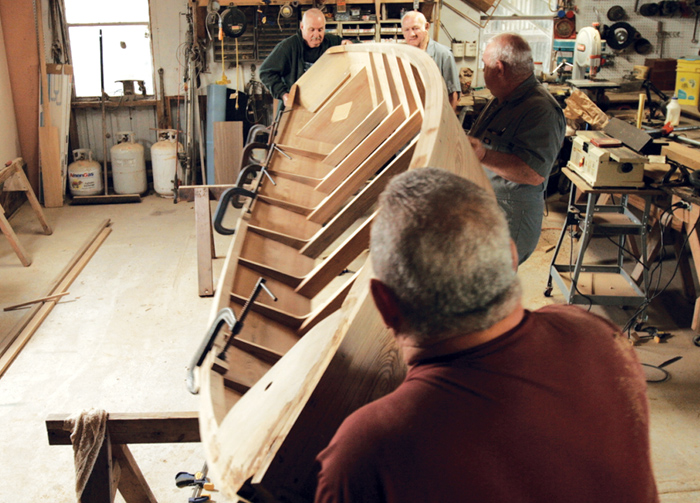
Photo by Brian C. Miller Richard.
Over time, Couvillier assembles in his mind a perfectly proportioned image of his boat—each tight angle, every shapely curve and contour, a faultless geometry of intricate detail that he can rotate in any direction within a three-dimensional mental space. With only a grammar school education, the old boat builder is able to use his brain in ways that often elude trained engineers and visual artists.
Not everyone can do what Couvillier can. Sir Francis Galton, a 19th century polymath, was the first to try to apply scientific methods to the study of mental imagery. He began by surveying a large sample of his fellow scientists in Britain. With a very simple questionnaire, he asked them to visualize, as vividly as possible, what had been set before them that morning at the breakfast table.
Not surprisingly, some respondents were able to recall images in much greater detail than others—the colors of the food, the spatial arrangement of the plates and silverware. But some, to Galton’s amazement, dismissed his questions out of hand, declaring that although they could accurately remember propositional facts about their breakfasts, the notion of summoning a “mental picture” was absurd. For the next hundred years or so, psychologists, philosophers and neuroscientists fiercely argued the question of why.
Why are people, like Edward Couvillier, capable of conjuring mental images, intricately detailed and spatially precise, while others can’t do it all, or even comprehend the idea that others can?
“Well, no one knows.”
That’s the answer I got from Dr. Stephen Kosslyn, former chair of the psychology department at Harvard University and, by most accounts, one of the world’s foremost cognitive neuroscientists in the field of mental imagery. He explained that differences between people in their ability to visualize are likely the product of many factors. Research shows that, to a significant extent, complex spatial thinking skills like Couvillier’s can be developed through learning and practice. Genetics undoubtedly plays a role, he said, but perhaps no more than upbringing and environment.
For weeks, Couvillier says, the boat he’ll build is the last thing he sees when he closes his eyes at night and the first thing before he opens them again the next morning. “A lot of times you dream about it,” he adds.
“Probably it’s in the interaction between the two. So it’s like everything else. It’s not simple. I don’t think anybody actually knows.”
Nevertheless, a large share of what we do know about mental imagery today comes to us from researchers like Kosslyn and his colleagues.
In one of their more well-known experiments, for example, test subjects undergoing a neuro-scan were asked to look at a picture of an object. The fMRI clearly showed which parts of the brain were activated by the visual stimulus caused by the picture before their eyes. However, when subjects were asked to simply visualize that object, the scans revealed that the areas of the brain that “lit up” were virtually identical, even in the absences of any external cause or visual stimulus. Apparently, in terms of overall neurological function, there’s little distinction between what happens when the optic nerve and visual cortex are stimulated to generate the perception of something, and what occurs when that thing is remembered or imagined vividly. To the brain, when a master craftsman like Edward Couvillier “just pictures the boat in his mind,” it really is as though he is looking at something that isn’t there.
It’s a proud moment when Edward Couvillier’s finished skiff finally slides backward from the boat trailer and slips into the glassy waters of the Teche. Quietly, there has been some worry among his sons whether the old man will still remember how to work the long oars. Piloting a push skiff can be tricky, and it has been more than 60 years since Couvillier last rowed a boat like this.
We look on as the old man steps down from the dock, steadies himself in the skiff, and finally straightens to stand behind the joug, ready to row.
I find myself recalling something said by one of Couvillier’s sons on the day they completed construction of the vessel.
“You know, there really just isn’t any good reason to build a boat like this nowadays,” Larry Couvillier had remarked. “Except for show.”
It’s true. Since the advent of gasoline-driven motors sometime around the mid-twentieth century, followed by fiberglass and aluminum hulls, wooden rowboats really have had no place in the Basin anymore. The folks who traditionally made their home here were, above all, eminently sensible people. In an environment as unforgiving as this, they could never afford to put nonsense like nostalgia ahead of practical utility.
His father, his brothers, and all the old men who’d gathered to watch the building of this boat knew that what Larry said was correct. But just the same, everyone seemed sorry he’d said it. Although unspoken, it was well understood that something irreplaceable would be lost when the memory of how to build such boats finally fades.
But I don’t think it’s the extinction of the Basin’s cypress boats that’s most regrettable, nor even the loss of Louisiana’s rare designs. These things are precious, to be sure. What I worry about most, rather, is the disappearance of something more valuable. It’s a way of thinking that’s become unfamiliar to a great many of us; a use of memory and imagination that allows the maker to see a thing that isn’t there, so vividly, so precisely, that his hands simply give form to what’s in his thoughts. It’s something that comes naturally to Couvillier and the master craftsmen of past generations.
We continue to watch from the dock. For a nervous moment, the old boat builder fumbles with the long oars and the skiff wobbles in the water under him. Then, like suddenly recalling a name that has been at the tip of one’s tongue for a long time, Couvillier unconsciously rights himself, dips the oars and pushes forward across the bayou in smooth, familiar strokes.
—–
C.E. Richard teaches creative writing and film at the University of Louisiana at Lafayette. The forthcoming book, Land’s End: Field Notes from the ‘End of the World,’ is a collection of his literary nonfiction about cultural loss and coastal erosion in Louisiana, due out from McFarland in 2017.
